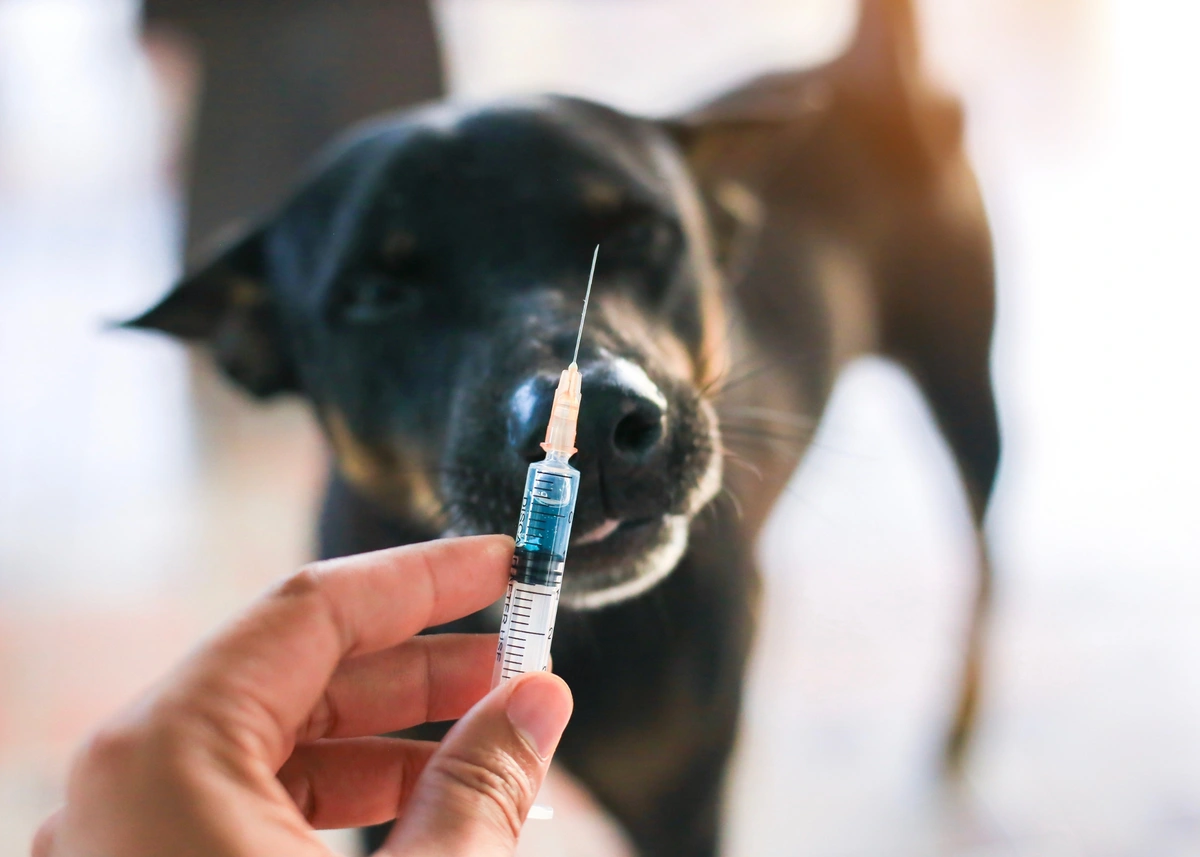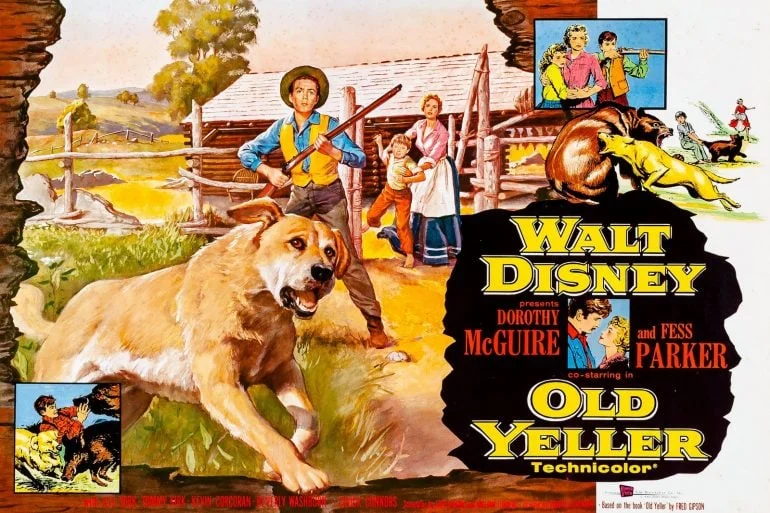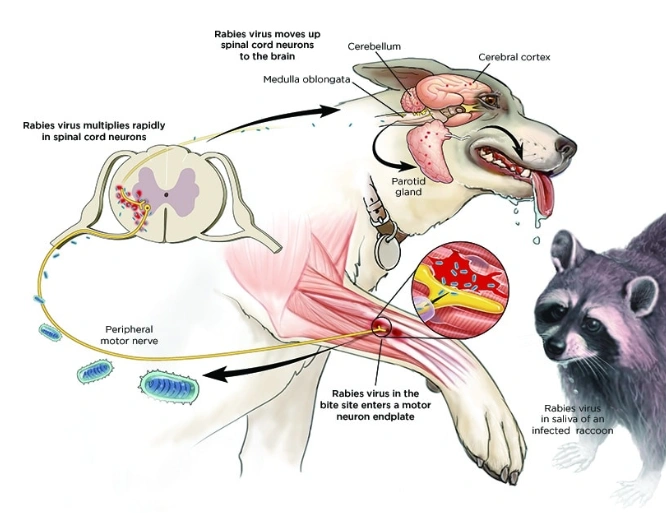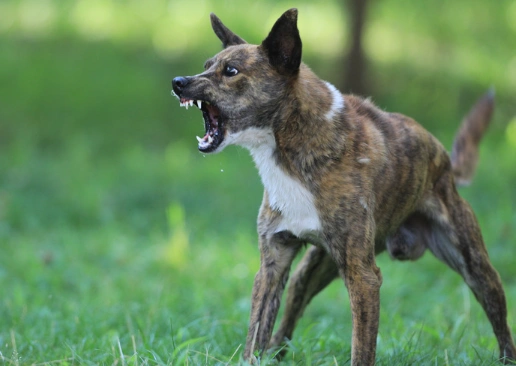Many of us were introduced to understanding rabies from books or movies we saw as children. In the book and film “Old Yeller,” owner Travis Coates has to shoot his beloved canine companion, Old Yeller after the dog was bitten by a rabid wolf while defending the family. The scene at the end is devastating and heartbreaking as they say goodbye to their family dog.
In Harper Lee’s American classic “To Kill a Mockingbird,” a rabid dog named Tim Johnson threatens the citizens of Maycomb. Lee paints an accurate picture of what a dog acts like when infected with rabies, describing its erratic actions in great detail. After shooting Tim Johnson, Atticus Finch cautions his young son, Jem: “Don't you go near that dog, you understand? Don't go near him, he's just as dangerous dead as alive.”
Rabies in dogs poses a significant public health risk, underscoring the importance of responsible pet ownership and timely vaccinations. The virus can cause extreme behavioral changes in dogs, such as aggression and agitation, leading to the historical association with madness, a characteristic feature of rabies throughout history.
Rabies has been feared throughout history, but it has only been through modern scientific progress that we have a vaccine. The ultimate goal will be to find a cure one day. Until then, drastic public measures on the federal level and below have mandated rules and regulations about companion pets being vaccinated against rabies.
Rabies is a devastating disease dogs don’t have to experience. Learn about the signs and symptoms of rabies in dogs and the importance of being current on your dog’s rabies vaccinations.
Is Rabies in Dogs a New Threat?
The word “rabies” has a few origins that shed light on the nature of this virus. The Sanskrit word “rabhas” means “to do violence,” and the Latin “rabere” means “fury, rage, or madness.” Ancient Greeks called it “lyssa,” which translates as “violence,” and now the genus of viruses causing rabies is called Lyssaviruses.
Rabies is not a modern disease; in fact, the first record of rabies causing death in both humans and dogs appearing in written form is from the Mosaic Esmuna Code of Babylon in 2300 B.C.E. Rabies has terrorized cultures across the globe for centuries and continues to this day in underdeveloped countries.
The United States of America and other countries have taken strict measures to mitigate rabies in both wild and domestic animals. Only around 60-70 dogs each year in the US are reported to have rabies, the majority of these dogs being unvaccinated, proof that mitigation measures are working.
Rabies is a huge problem to this day in several countries without laws and regulations to prevent or mitigate rabies. However, several global organizations are coming together to help eradicate rabies.
World Rabies Day
World Rabies Day is an international awareness campaign observed on September 28th each year to raise awareness about the dangers of rabies and to promote rabies prevention and control efforts. It was initiated by the Global Alliance for Rabies Control (GARC), a non-profit organization dedicated to eliminating rabies worldwide, and also works with the World Health Organization (WHO).
The campaign focuses on educating people about the importance of responsible pet ownership, rabies vaccination for dogs and cats, and the need for immediate medical attention if bitten by a potentially rabid animal.
World Rabies Day serves as a reminder of the global efforts required to eliminate this deadly disease and emphasizes the role of individuals, communities, and governments in achieving this goal. It also honors the memory of Louis Pasteur on his death September 28, who developed the first rabies vaccine and made significant contributions to our understanding of rabies.
America’s Efforts to Fight Rabies
Rabies vaccines for dogs are mandatory, highly regulated, and tested in America with teams of agencies working in tandem to prevent rabies.
The USDA Center for Veterinary Biologics licenses and regulates veterinary rabies vaccines. Licensed veterinarians may only use USDA-approved rabies vaccines approved by a commission. In addition, the National Association of State Public Health Veterinarians produces a document for lawmakers who make and enforce local rabies laws to support rabies vaccination efforts.
Owners are not allowed to vaccinate their own pets against rabies, as it must be done by a licensed veterinarian or certified rabies vaccinator and receive a certificate of proof to keep for the owner’s records.
Laws regarding rabies vary by state and municipality, but they typically mandate rabies vaccinations for domestic dogs and cats. These laws aim to prevent the spread of the virus to humans and other animals. Additionally, they may require immediate reporting of animal bites to health authorities for potential rabies exposure. Stray animal control and quarantine measures are often enforced to mitigate rabies transmission. Compliance with these laws is crucial for public health and pet safety. Fines can be steep for those who do not comply, and your dog may even face euthanization if you refuse to vaccinate your dog.
State laws require all dog owners must start vaccinations at 4 months of age and continue throughout their lifetime. Owners have to keep paperwork for dogs, cats, and ferrets, and there are no exemptions to the law granted for any reason.
All About the Rabies Vaccine For Dogs
Vaccines for humans and dogs come in many forms and are made in several ways depending on the nature of the disease it is meant to prevent. The rabies vaccine is an inactivated vaccine, meaning it contains an inactivated (dead) virus. Their immune systems learn to fight it off, but it poses no danger to dogs and cannot replicate itself in their bodies because it is not a live virus. It is administered via a subcutaneous or intramuscular injection.
The rabies vaccination schedule for dogs begins when your puppy is about 14-16 weeks old, followed by a booster one year after receiving the vaccine. After the first booster, your dog will need a rabies shot every 3 years.
Does the rabies vaccine for dogs prevent the virus?
If you let your rabies vaccine booster slide, your dog may still be protected, but because each animal is different, there is no guarantee.
Just because your dog is vaccinated does not mean they cannot get rabies, much like humans can still get the flu even when receiving vaccinations. While the chance of a vaccinated dog getting rabies is low, a rabies vaccine for dogs does not guarantee 100% protection. However, the vaccine does produce antibodies to fight off the virus.
How Does My Dog Contract Rabies?
Rabies is transmitted through the saliva of an infected mammal, usually through animal bites or exposure to infected saliva through broken skin, eyes, ears, or mouth. The animal can still transmit rabies even after it is dead. In addition to dogs, mammals such as cats, ferrets, skunks, wolves, coyotes, possums, horses, cows, bats, and more can spread rabies – even camels.
Rabies doesn’t affect an animal immediately, as it has an incubation period and progresses in a series of symptoms. An infected dog can transmit rabies to humans and other pets during the incubation time before showing symptoms if the virus has already made its way into the dog’s saliva.
Pathogenesis of rabies courtesy of Today's Veterinary Practice
What Are the Signs and Symptoms of Rabies?
While it may be awful to hear about such a devastating virus, it’s important to understand rabies progression in dogs to realize how serious the issue can be to your beloved puppy. Rabies symptoms can vary, and not all dogs will exhibit the same signs.
There is no test to determine whether or not your puppy has been infected with rabies. The only way to know for sure an infection was indeed rabies, even if all the signs and symptoms were present, is to take brain tissue samples after death. Rather, vets will often look for signs and symptoms along with searching for a bite site and asking you various questions to determine where and when the bite may have occurred.
Bite marks & behavior
If you notice a bite or were present during the bite from a rabid animal, remove your dog from the situation immediately, and wash the wound with soap and water. Take your dog to an emergency veterinarian or animal hospital right away. Do not try to ride it out or wait for it to clear because it will only get progressively worse without intervention.
Likewise, if you notice your dog’s behavior lines up with the signs and symptoms, take your dog in immediately for evaluation. In the thick of it all, try to remember to call local animal control to report a possibly rabid animal.
If a rabid animal bites a dog and the dog has been vaccinated, the chances of contracting rabies are low but not impossible. Bitten dogs will usually be given another booster and placed in a monitored quarantine for 10-30 days to see if symptoms begin appearing. The law requires your veterinarian to notify the local and state animal disease regulatory authorities who then decide the steps to take to properly protect the public.
Right after the bite
Once a mammal is bitten, the rabies virus replicates in the muscle tissue, making its way to the peripheral nervous system at the neuromuscular junction. It will then move into the brain and the salivary glands, which is why you hear of the telltale foaming at the mouth and drooling.
Incubation
The incubation period for rabies in dogs can last anywhere from 10 days to over a year! The average incubation period is two weeks to four months. How quickly the rabies virus progresses through a dog’s body depends on how close the bite is to the spinal cord and brain, the bite’s severity, and the amount of virus transmitted through the bite. This is why it’s important to stay up to date on vaccinations, monitor your dog’s behavior, and seek medical care immediately if you suspect he or she has been bitten by an infected animal.
Prodromal stage
The rabies virus then begins to multiply rapidly in the brain before traveling to the saliva glands. One of the first signs of rabies in dogs is a personality change. Dogs with rabies may exhibit behavioral changes, such as aggression, restlessness, or excessive excitement. Affected dogs may appear disoriented, confused, or agitated.
Rabies can then develop into either the furious stage or the paralytic stage – or cause symptoms of both.
Furious stage
The furious stage of rabies in dogs is marked by intense aggression, restlessness, and hyperactivity. Dogs may become highly excitable, irritable, and exhibit erratic behavior. Excessive salivation, difficulty swallowing, and foaming at the mouth are common. This stage is characterized by extreme aggression and agitation, making affected dogs a danger to others.
Paralytic stage
The paralytic stage of rabies in dogs is characterized by muscle weakness and paralysis. It typically begins with a dropped jaw, causing excessive drooling. As the disease progresses, paralysis spreads throughout the body, leading to difficulty in breathing and eventually respiratory failure.
Unlike the furious stage, dogs with paralytic rabies may not display aggression but instead exhibit a profound loss of motor control, making them unable to eat, drink, or move.
End stage
An unvaccinated dog can die within seven days, either by a violent seizure or a comatose end. It’s painful, ugly – and preventable.
Is There a Cure for Rabies?
We hate to be the bearer of bad news, but there is no cure for rabies in dogs, and it is always fatal in infected dogs. In America, dogs with rabies are humanely euthanized, as there is no treatment to reduce or reverse its course in an unvaccinated dog.
How Can I Prevent My Dog From Catching Rabies?
Even though rabies can be terrifying, that doesn’t mean you can’t do anything about it. In fact, there are lots of ways to prevent rabies in your dog.
- The best way to protect your dog against rabies is to vaccinate your dog on the recommended schedule.
- Know your local and state rabies regulations and laws and abide by them.
- Keep your dog on a leash to reduce the risk of sniffing and eating a dead animal.
- Be vigilant on your walks for animals behaving erratically. Call animal control if you suspect a wild animal has rabies.
- If your dog is bitten by another dog, ask for proof of their rabies vaccine. You are within your right to call animal control if they refuse to produce a copy or if the vaccine is expired as a possible public health threat.
- Take action right away if your dog is bitten by a wild animal. Better safe than sorry!
- Secure your trash to reduce wild animals around your home.
- Avoid direct contact with wild animals, and do not keep them as pets.
Keep a Pawrade Puppy Up to Date on Rabies Vaccinations
Part of being a responsible dog owner is making sure you provide your puppy with all its core vaccinations. Another way to get a great start is to find puppies for sale from a reputable breeder who has cared for the puppy before they were even born providing great care for the dam and sire.
At Pawrade, we partner with trustworthy breeders and offer a comprehensive health guarantee while taking a puppy first approach, where we place the health and happiness of puppies above everything else. You can rest assured our breeders love your puppy like you do and want to see them healthy and current on vaccinations after they leave their care and leap into your loving arms.
Browse our available puppies for sale for the right puppy to adopt, and be sure to protect your new furbaby from rabies through responsible pet ownership practices. Your puppy’s life depends on it!





